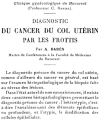Current classification systems and standardized terminology in cytopathology
- PMID: 33817706
- PMCID: PMC8112797
- DOI: 10.47162/RJME.61.3.03
Current classification systems and standardized terminology in cytopathology
Abstract
The history of classification systems and the search for a unified nomenclature in cytopathology spans several decades and expresses the preoccupation of all those involved to make cytopathology a reliable diagnostic tool and a trusted screening method. Early classification schemes, applicable to exfoliative and aspiration cytology, attempted to set some basic standards for how non-gynecological cytopathology findings should be reported. While useful in establishing some basic guidelines, these were not specific to the various fields of non-gynecologic cytopathology, often burdened with specific problems. Cytopathology has evolved tremendously in the last couple of decades, undoubtedly boosted by the emergence of various classification schemes that, more than ever, are based on evidence gathered by professionals across the globe. The benefit of classification systems and standardized nomenclature in cytopathology is to provide useful, clear, and clinically relevant information for clinicians and ultimately to provide the best patient care. Standardized reporting systems make cytopathology reports more meaningful and robust. It now became standard that these include by default elements, such as adequacy criteria, diagnostic groups, risk of malignancy (ROM), and recommendations for patient management. In this brief review, we attempted to summarize how these classification schemes emerged and how they are reshaping the landscape of diagnostic cytopathology.
Conflict of interest statement
The author declares that there is no conflict of interests.
Figures


References
-
- Sundling KE, Kurtycz DFI. Standardized terminology systems in cytopathology. Diagn Cytopathol. 2019;47(1):53–63. - PubMed
-
- Juskevicius R, Zou KH, Cibas ES. An analysis of factors that influence the ASCUS/SIL ratio of pathologists. Am J Clin Pathol. 2001;116(3):331–335. - PubMed
-
- Vanderlaan PA, Krane JF, Cibas ES. The frequency of ‘atypia of undetermined significance’ interpretations for thyroid fine-needle aspirations is negatively correlated with histologically proven malignant outcomes. Acta Cytol. 2011;55(6):512–517. - PubMed
-
- ***. Classes in Oncology: George Nicholas Papanicolaou’s new cancer diagnosis presented at the Third Race Betterment Conference Battle Creek Michigan January 2-6 1928 and published in the Proceedings of the Conference. CA Cancer J Clin. 1973;23(3):174–179. - PubMed
Publication types
MeSH terms
LinkOut - more resources
Full Text Sources
Other Literature Sources
Medical

